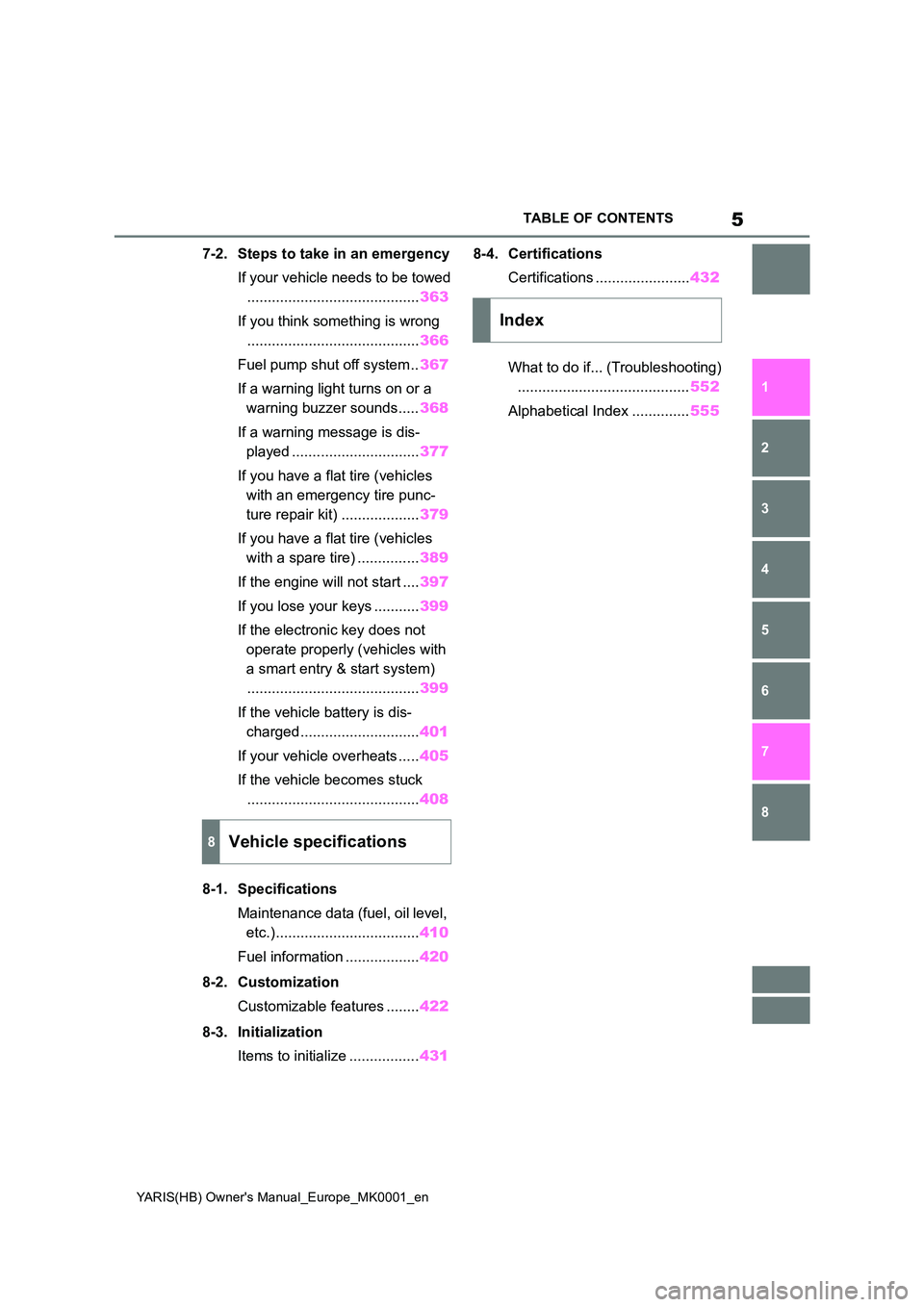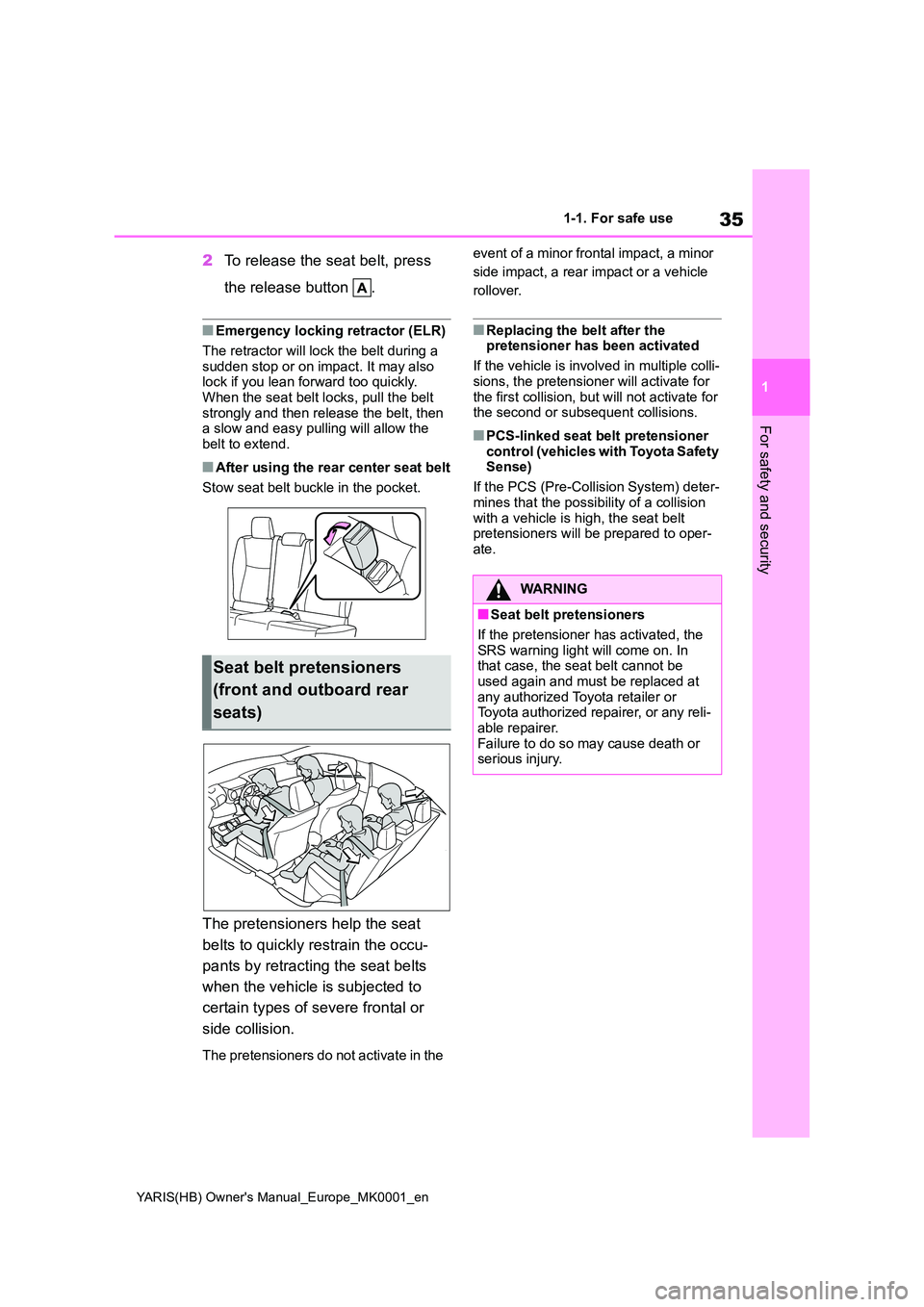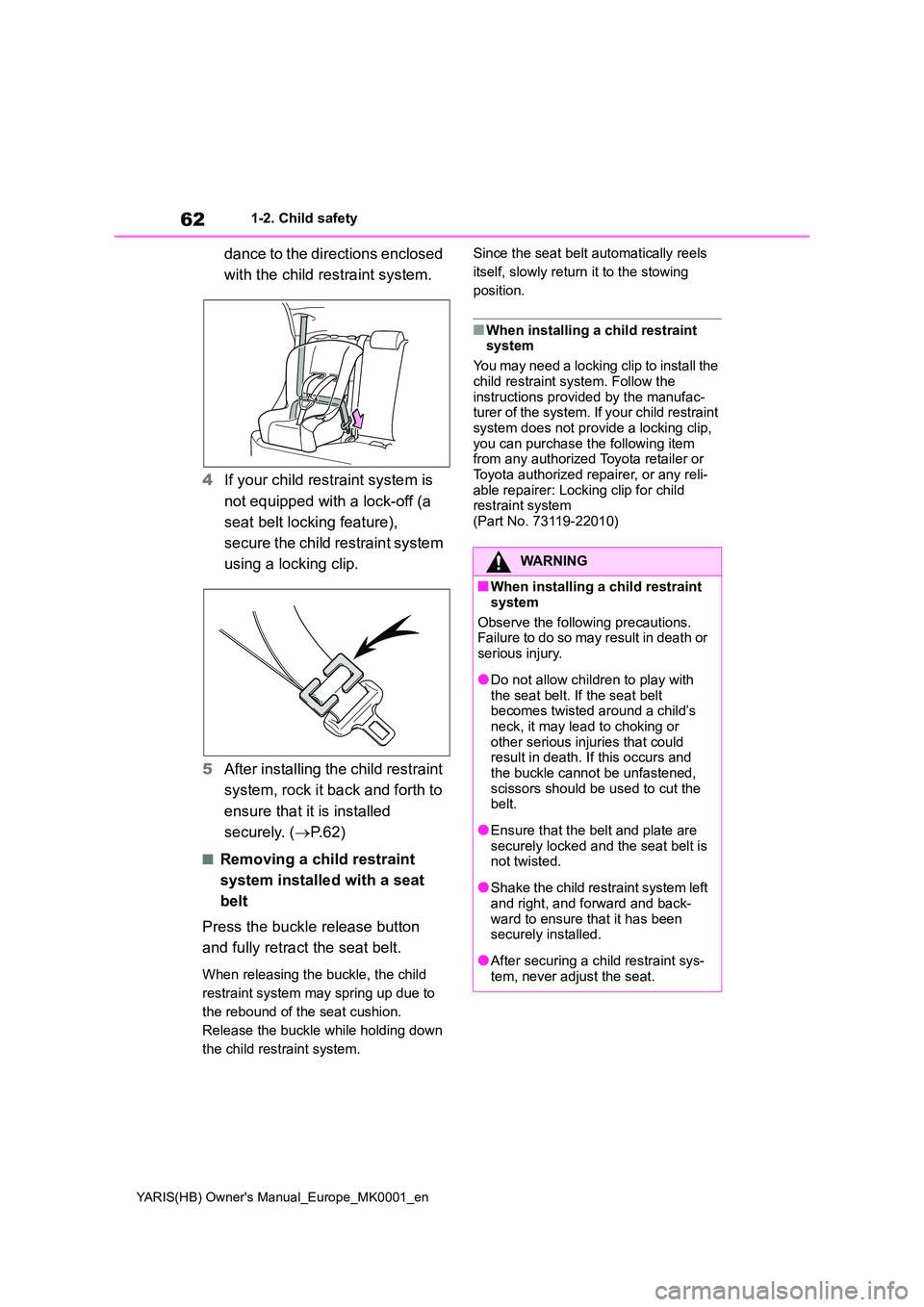2021 TOYOTA YARIS HATCHBACK tow
[x] Cancel search: towPage 3 of 568

3
YARIS(HB) Owner's Manual_Europe_MK0001_en
TABLE OF CONTENTS
1
6
5
4
3
2
8
7
3-5. Opening and closing the win-
dows
Power windows ................... 139
4-1. Before driving
Driving the vehicle .............. 144
Cargo and luggage ............. 151
Trailer towing (vehicles without
towing packages - including
Reunion) ........................... 152
Trailer towing (vehicles with tow-
ing packages - except for
Reunion) ........................... 152
4-2. Driving procedures
Engine (ignition) switch (vehicles
without a smart entry & start
system) ............................. 158
Engine (ignition) switch (vehicles
with a smart entry & start sys-
tem) .................................. 159
Multidrive ............................ 164
Manual transmission ........... 168
Turn signal lever ................. 171
Parking brake...................... 171
4-3. Operating the lights and wip-
ers
Headlight switch.................. 173
Automatic High Beam ......... 177
Fog light switch ................... 180
Windshield wipers and washer
.......................................... 181
Rear window wiper and washer
.......................................... 184
4-4. Refueling
Opening the fuel tank cap ... 186
4-5. Using the driving support sys-
tems
Toyota Safety Sense ........... 188
PCS (Pre-Collision System) 193
LTA (Lane Tracing Assist) ... 203
Dynamic radar cruise control
.......................................... 213
Speed limiter ....................... 224
RSA (Road Sign Assist) ...... 226
Stop & Start system ............ 230
BSM (Blind Spot Monitor) ... 237
Toyota parking assist-sensor
.......................................... 242
RCTA (Rear Crossing Traffic
Alert) ................................. 247
PKSB (Parking Support Brake)
.......................................... 251
Parking Support Brake function
(static objects) .................. 256
Parking Support Brake function
(rear-crossing vehicles) .... 262
Driving mode select switch . 266
GPF (Gasoline Particulate Filter)
system .............................. 267
Driving assist systems ........ 268
4-6. Driving tips
Winter driving tips ............... 274
4Driving
Page 5 of 568

5
YARIS(HB) Owner's Manual_Europe_MK0001_en
TABLE OF CONTENTS
1
6
5
4
3
2
8
7
7-2. Steps to take in an emergency
If your vehicle needs to be towed
.......................................... 363
If you think something is wrong
.......................................... 366
Fuel pump shut off system .. 367
If a warning light turns on or a
warning buzzer sounds..... 368
If a warning message is dis-
played ............................... 377
If you have a flat tire (vehicles
with an emergency tire punc-
ture repair kit) ................... 379
If you have a flat tire (vehicles
with a spare tire) ............... 389
If the engine will not start .... 397
If you lose your keys ........... 399
If the electronic key does not
operate properly (vehicles with
a smart entry & start system)
.......................................... 399
If the vehicle battery is dis-
charged............................. 401
If your vehicle overheats ..... 405
If the vehicle becomes stuck
.......................................... 408
8-1. Specifications
Maintenance data (fuel, oil level,
etc.)................................... 410
Fuel information .................. 420
8-2. Customization
Customizable features ........ 422
8-3. Initialization
Items to initialize ................. 431
8-4. Certifications
Certifications ....................... 432
What to do if... (Troubleshooting)
.......................................... 552
Alphabetical Index .............. 555
8Vehicle specifications
Index
Page 14 of 568

14
YARIS(HB) Owner's Manual_Europe_MK0001_en
Pictorial index
■Instrument panel (left-hand drive vehicles)
Engine switch .........................................................................P.158, 159
Starting the engine/changing the positions*1...................................P.158
Starting the engine/changing the modes*2.......................................P.159
Emergency stop of the engine .........................................................P.360
When the engine will not start ..........................................................P.397
Warning messages ..........................................................................P.377
Shift lever................................................................................P.164, 168
Changing the shift position.......................................................P.164, 168
Precautions for towing .....................................................................P.363
When the shift lever does not move*3..............................................P.165
Meters .........................................................................................P.86, 90
Reading the meters/adjusting the instrument panel light .............P.86, 90
Warning lights/indicator lights ............................................................P.82
When a warning light turns on .........................................................P.368
Page 21 of 568

21
YARIS(HB) Owner's Manual_Europe_MK0001_en
Pictorial index
■Instrument panel (right-hand drive vehicles)
Engine switch .........................................................................P.158, 159
Starting the engine/changing the positions
*1...................................P.158
Starting the engine/changing the modes
*2.......................................P.159
Emergency stop of the engine .........................................................P.360
When the engine will not start ..........................................................P.397
Warning messages ..........................................................................P.377
Shift lever................................................................................P.164, 168
Changing the shift position.......................................................P.164, 168
Precautions for towing .....................................................................P.363
When the shift lever does not move
*3..............................................P.165
Meters .........................................................................................P.86, 90
Reading the meters/adjusting the instrument panel light .............P.86, 90
Warning lights/indicator lights ............................................................P.82
When a warning light turns on .........................................................P.368
Page 35 of 568

35
1
YARIS(HB) Owner's Manual_Europe_MK0001_en
1-1. For safe use
For safety and security
2To release the seat belt, press
the release button .
■Emergency locking retractor (ELR)
The retractor will lock the belt during a sudden stop or on impact. It may also lock if you lean forward too quickly.
When the seat belt locks, pull the belt strongly and then release the belt, then a slow and easy pulling will allow the
belt to extend.
■After using the rear center seat belt
Stow seat belt buckle in the pocket.
The pretensioners help the seat
belts to quickly restrain the occu-
pants by retracting the seat belts
when the vehicle is subjected to
certain types of severe frontal or
side collision.
The pretensioners do not activate in the
event of a minor frontal impact, a minor
side impact, a rear impact or a vehicle
rollover.
■Replacing the belt after the pretensioner has been activated
If the vehicle is involved in multiple colli-
sions, the pretensioner will activate for the first collision, but will not activate for the second or subsequent collisions.
■PCS-linked seat belt pretensioner
control (vehicles with Toyota Safety Sense)
If the PCS (Pre-Collision System) deter-
mines that the possibility of a collision with a vehicle is high, the seat belt pretensioners will be prepared to oper-
ate.
Seat belt pretensioners
(front and outboard rear
seats)
WARNING
■Seat belt pretensioners
If the pretensioner has activated, the SRS warning light will come on. In that case, the seat belt cannot be
used again and must be replaced at any authorized Toyota retailer or Toyota authorized repairer, or any reli-
able repairer. Failure to do so may cause death or serious injury.
Page 41 of 568

41
1
YARIS(HB) Owner's Manual_Europe_MK0001_en
1-1. For safe use
For safety and security
WARNING
■SRS airbag precautions
Observe the following precautions
regarding the SRS airbags. Failure to do so may cause death or serious injury.
●The driver and all passengers in the vehicle must wear their seat belts
properly. The SRS airbags are supplemental devices to be used with the seat
belts.
●The SRS driver airbag deploys with
considerable force, and can cause death or serious injury especially if the driver is very close to the air-
bag.
Since the risk zone for the driver’s air-
bag is the first 50 - 75 mm (2 - 3 in.) of
inflation, placing yourself 250 mm (10
in.) from your driver airbag provides
you with a clear margin of safety. This
distance is measured from the center
of the steering wheel to your breast-
bone. If you sit less than 250 mm (10
in.) away now, you can change your
driving position in several ways:
• Move your seat to the rear as far as you can while still reaching the ped-als comfortably.
• Slightly recline the back of the seat. Although vehicle designs vary,
many drivers can achieve the 250 mm (10 in.) distance, even with the driver seat all the way forward, sim-
ply by reclining the back of the seat somewhat. If reclining the back of your seat makes it hard to see the
road, raise yourself by using a firm, non-slippery cushion, or raise the seat if your vehicle has that feature.
• If your steering wheel is adjustable, tilt it downward. This points the air-
bag toward your chest instead of your head and neck.
The seat should be adjusted as rec-ommended above, while still main-taining control of the foot pedals,
steering wheel, and your view of the instrument panel controls.
●The SRS front passenger airbag also deploys with considerable force, and can cause death or seri-
ous injury especially if the front pas- senger is very close to the airbag. The front passenger seat should be
as far from the airbag as possible with the seatback adjusted, so the front passenger sits upright.
●Improperly seated and/or restrained infants and children can be killed or
seriously injured by a deploying air- bag. An infant or child who is too small to use a seat belt should be
properly secured using a child restraint system. Toyota strongly recommends that all infants and
children be placed in the rear seats of the vehicle and properly restrained. The rear seats are safer
for infants and children than the front passenger seat. ( →P. 4 7 )
●Do not sit on the edge of the seat or lean against the dashboard.
Page 42 of 568

42
YARIS(HB) Owner's Manual_Europe_MK0001_en
1-1. For safe use
WARNING
●Do not allow a child to stand in front of the SRS front passenger airbag
unit or sit on the knees of a front passenger.
●Do not allow the front seat occu-pants to hold items on their knees.
●Do not lean against the door, the roof side rail or the front, side and rear pillars.
●Do not allow anyone to kneel on the passenger seat toward the door or
put their head or hands outside the vehicle.
●Do not attach anything to or lean anything against areas such as the dashboard or steering wheel pad.
These items can become projec- tiles when the SRS driver and front passenger airbags deploy.
●Do not attach anything to areas such as a door, windshield, side
windows, front or rear pillar, roof side rail and assist grip. (Except for the speed limit label →P.382)
●Do not hang coat hangers or other hard objects on the coat hooks. All
of these items could become pro- jectiles and may cause death or serious injury, should the SRS cur-
tain shield airbags deploy.
●Do not use seat accessories which
cover the parts where the SRS side airbags inflate as they may interfere with inflation of the SRS airbags.
Such accessories may prevent the side airbags from activating cor-rectly, disable the system or cause
the side airbags to inflate acciden- tally, resulting in death or serious injury.
Page 62 of 568

62
YARIS(HB) Owner's Manual_Europe_MK0001_en
1-2. Child safety
dance to the directions enclosed
with the child restraint system.
4 If your child restraint system is
not equipped with a lock-off (a
seat belt locking feature),
secure the child restraint system
using a locking clip.
5 After installing the child restraint
system, rock it back and forth to
ensure that it is installed
securely. ( →P. 6 2 )
■Removing a child restraint
system installed with a seat
belt
Press the buckle release button
and fully retract the seat belt.
When releasing the buckle, the child
restraint system may spring up due to
the rebound of the seat cushion.
Release the buckle while holding down
the child restraint system.
Since the seat belt automatically reels
itself, slowly return it to the stowing
position.
■When installing a child restraint system
You may need a locking clip to install the
child restraint system. Follow the instructions provided by the manufac-turer of the system. If your child restraint
system does not provide a locking clip, you can purchase the following item from any authorized Toyota retailer or
Toyota authorized repairer, or any reli- able repairer: Locking clip for child restraint system
(Part No. 73119-22010)
WARNING
■When installing a child restraint
system
Observe the following precautions. Failure to do so may result in death or
serious injury.
●Do not allow children to play with
the seat belt. If the seat belt becomes twisted around a child’s neck, it may lead to choking or
other serious injuries that could result in death. If this occurs and the buckle cannot be unfastened,
scissors should be used to cut the belt.
●Ensure that the belt and plate are securely locked and the seat belt is not twisted.
●Shake the child restraint system left and right, and forward and back-
ward to ensure that it has been securely installed.
●After securing a child restraint sys-tem, never adjust the seat.